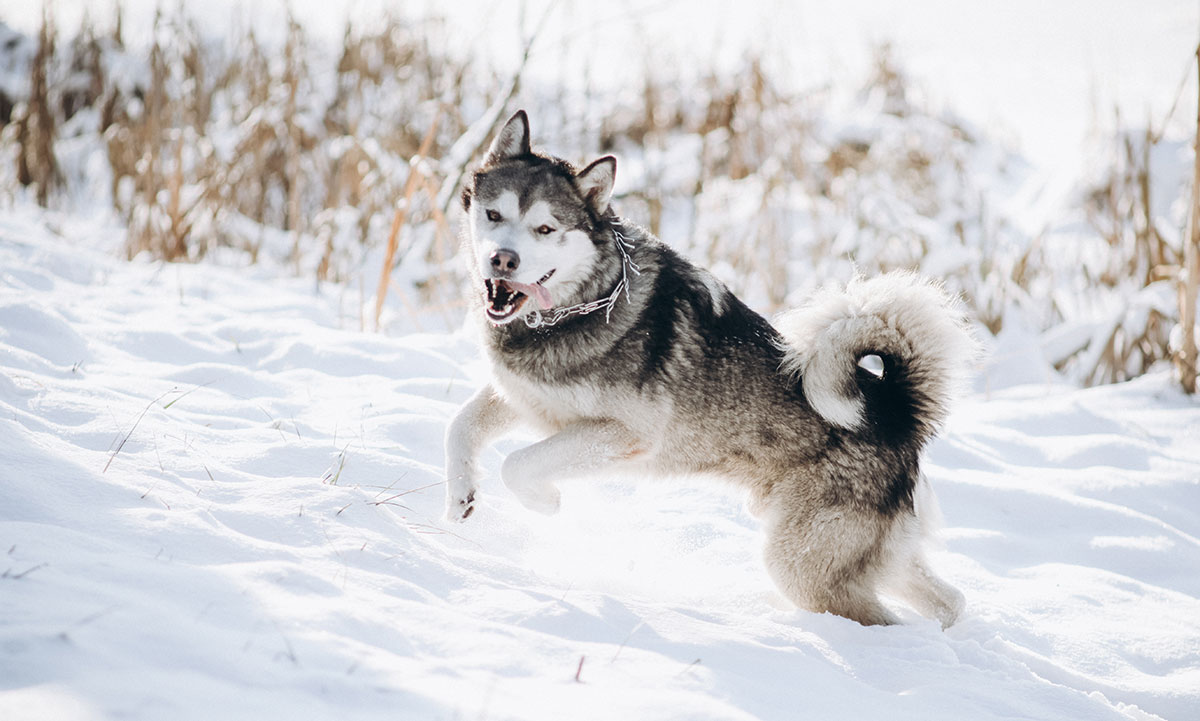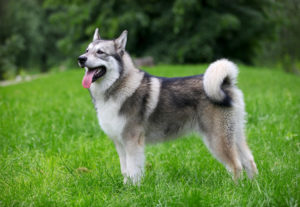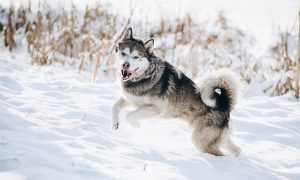
Alaskan Malamute

Image: Photobac/Shutterstock.com
| Name | Alaskan Malamute |
|---|---|
| Size | Medium |
| Grooming | At least daily |
| Training | Difficult |
| Exercise | Lots Think Twice a day + |
| Origins | Alaska |
Alaskan Malamute: Don't Call Me Husky
“No, it’s not a husky, and yes I know it looks like one. The two most frequent answers to questions posed to owners of Alaskan Malamute! Ok joking aside these hardy working dogs do bear a strong resemblance to their Siberian relatives however they are a distinct breed with differing strengths and lineage.
Anyway now we have cleared that up let's get down to whether this is the dog for you. Well if you have never kept a dog before, have young children and live in a city apartment then the answer is probably no (well you could have a huge penthouse flat with a huge roof garden and a permanent dog tender). They shed a lot so be prepared to do a lot of hoovering and you will ideally need to set aside daily grooming time.
However, if you love the outdoors have a house in the countryside with a big garden and live North of the Arctic Circle (you can ignore the last comment) then its a tentative yes.
You don't seem to be overselling them at this stage we hear you say. Well, the reason is we love dogs and it is better for you to get the right one than have to try and re-home one which you can't cope with, and one who will have grown attached to you. However, as you read on you will see that if you can give them the right amount of attention and the correct environment then they are great companions.
Ok, let's see what makes them so great...

Alaskan Malamute's are in their element when it snows! Image: Pryanett/Shutterstock.com
The Quick Overview
Name: Alaskan Malamute
Size: 23-25 inches tall
Weight: 75-85 pounds
Grooming: Daily – Double-Coated Dog
Training: Firm-but-gentle and from early puppyhood
Exercise: Energetic and needs daily attention and a big garden to play in
Temperament: Playful and loving, great with kids – if trained properly
Origins: Alaska…
Lifespan: 10-14 years old
Breed Type: WORKING DOG
History and origins of the Malamute Breed
Where the Husky and the Malamute might look like each other and both be working dogs; the Husky was created for long-distance running at speed. The Malamute was bred to be a sort of workhorse for Inuit tribes. They would be used to carry food and provisions over long treks, to haul kit or timber, to work sledges, to find seal holes in the ice… all sorts of things.
Where the Husky is Siberian in origin, the Malamute is believed to have been descended from the wolf dogs of old. Their very name comes from the Mahlemiut, an Inuit tribe who would migrate around the ice, following the bounty the seasons provided. Since they were nomadic, everything would be packed up and hauled every few months to chase food resources. This means that their dogs had to be big and strong to help them carry tents, supplies, or other vital provisions.
Nowadays there are three strains of the breed in America, as the population was decimated due to losses from their service in World War II. This all but eliminated the breed with there being as few as 30 registered in 1947. Also given Alaska is a huge territory, different genetics were favoured in different regions. The American Kennel Club recognises the Kotzebue, the M’Loot and the Hinman as variations and has since 1935.
They were not brought to Britain until 1959 so they are still a relatively new breed in the UK where they are listed under the Working Dog group by the UKKC.
Fun facts About the Alaskan Malamute
There are interesting titbits about every breed of dog and the Alaskan Malamute is no exception. Here are some of our favourite facts about them:
- It is believed this dog breed was used by the Paleo-Eskimo people, some 4,500 years ago.
- Both the Husky and the Malamute originated in Siberia. They both share genetics with the northern Spitz breeds, which are known as Utility dogs.
- You can get an Alaskan Husky, as well as a Siberian Husky. The reason we mention it here is that the Alaskan Husky is farther removed genetically from the Siberian Husky than a Malamute is. In fact, the Malamute and the Siberian are sorts of parent breeds for the Alaskan.
- These dogs are pack dogs… your family will be part of their pack. That’s great for you but not great for unexpected visitors to your home…
- And it means you should probably think about getting them a buddy.
These are fantastic animals that have been bred for strength and endurance. You will never win a tug of war with one, but you might earn their respect with consistent training. They are proud, historically significant, and in need of a lot of stimulation. Also, a country house with plenty of room for them to run around is best.
How easy is it to train an Alaskan Malamute?
The Malamute is stubborn and playful. They need high levels of stimulation and are quite intelligent. They will always try to be helpful, which makes them easy to train on one level. They can be stubborn and, should they not consider you a strong pack leader, they may choose to ignore you. They will do exceptionally well in training classes if you socialise them young and early. They will see the other dogs do it and want to show that they are better.
Warning: they have a high prey drive but don’t bark much. This is a deadly combination when you are on a walk and they see a squirrel. At least a terrier barks when it sees prey. The Alaskan Malamute will be off in a silent streak.
How Much Grooming Do Malamutes Need?
Daily, and more than that when they are shedding in summer. They are double-coated dogs, with a waterproof outer coat and a fluffy inner coat. The fluff is soft and warm but the two can become knotted. Worse, the shedding is out of control if you forget to brush them a day or two in a row.
Nature and Temperament
The Alaskan Malamute will love you to the ends of the earth. They are especially fond of people, having been bred in a world where their survival depended on their humans to find food in exceptionally harsh conditions. That being said, they are not the best dogs to have around kids on account of their size and strength. If you are looking for a dog the kids can walk in the evenings this isn’t it. Not if you like your kids, anyway.
Common Health Issues found in Alaskan Malamutes
The Malamute is a reasonably healthy breed considering its long history. The three health conditions you should be aware of with them are:
- A 2004 survey found the most common cause of death was cancer, at around 36%
- Hip Dysplasia – the socket part of the ball-and-socket hip joint grows in deformed
- Cataracts in the eyes
Where To Buy Your New Dog?
Normally, we would recommend you watch out for puppy breeders and report them to authorities while buying a new dog. With the Alaskan Malamute, things are a little different. They are far more likely to be Malamutes and Huskies at your local rehoming shelter than smaller, friendlier breeds. If a Malamute doesn’t respect, its owner as the leader of the pack it will make your life hell. This means you need to spend that initial few weeks building trust with the dog. It’s a bit tricky, takes finesse, and will be the exact same whether you buy a new puppy or rescue a full-grown dog.
We recommend buying from a shelter. If you phone around and can’t find one, then see the AKC or the UKKC for registered breeders.
Got Five Minutes?
If you like reading about dogs (who doesn’t?) and aren’t finished with your break yet, why not head over to our other pages for a browse? Learn about the Afghan Hound or find a good Gundog. We are going a little dog daft at Five Minutes Spare right now… and we don’t regret it one little bit!